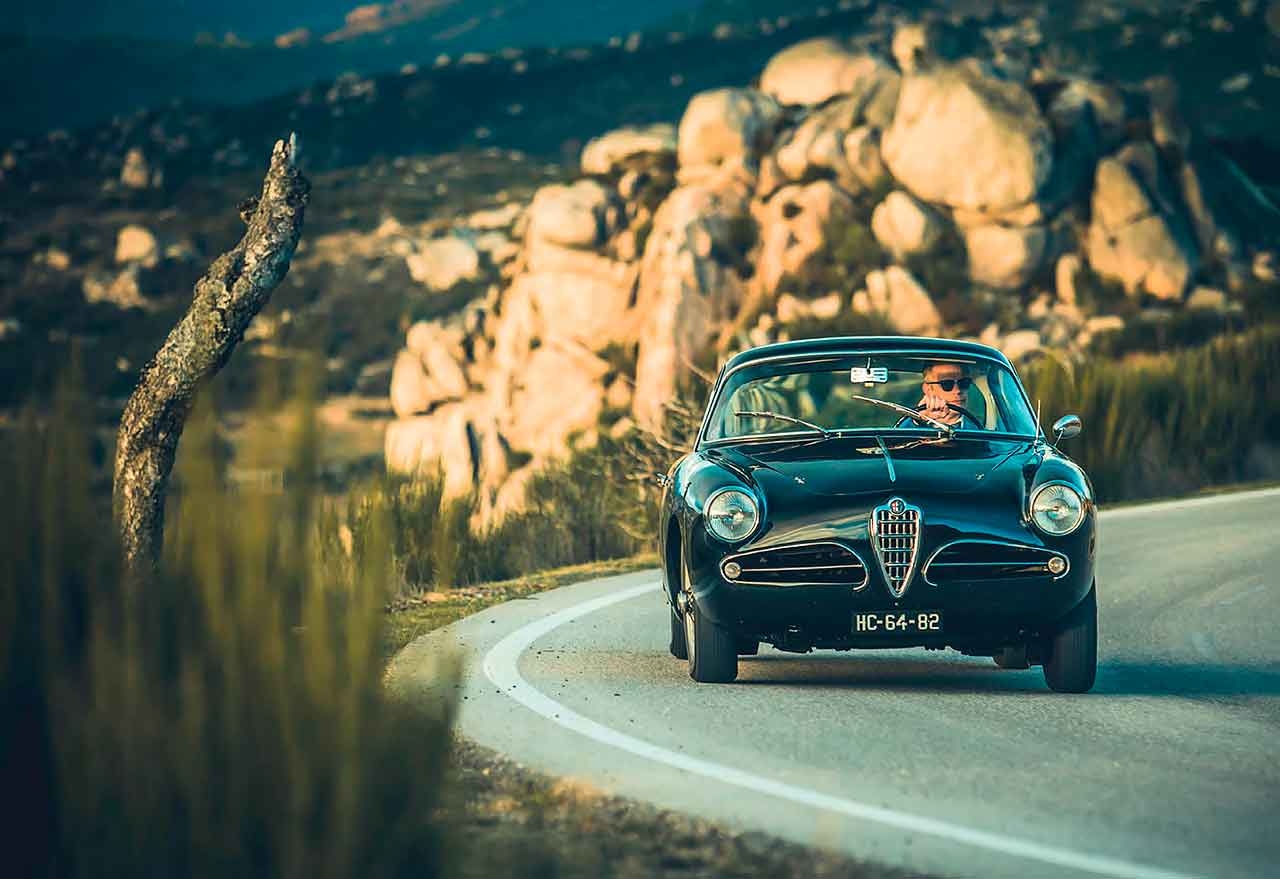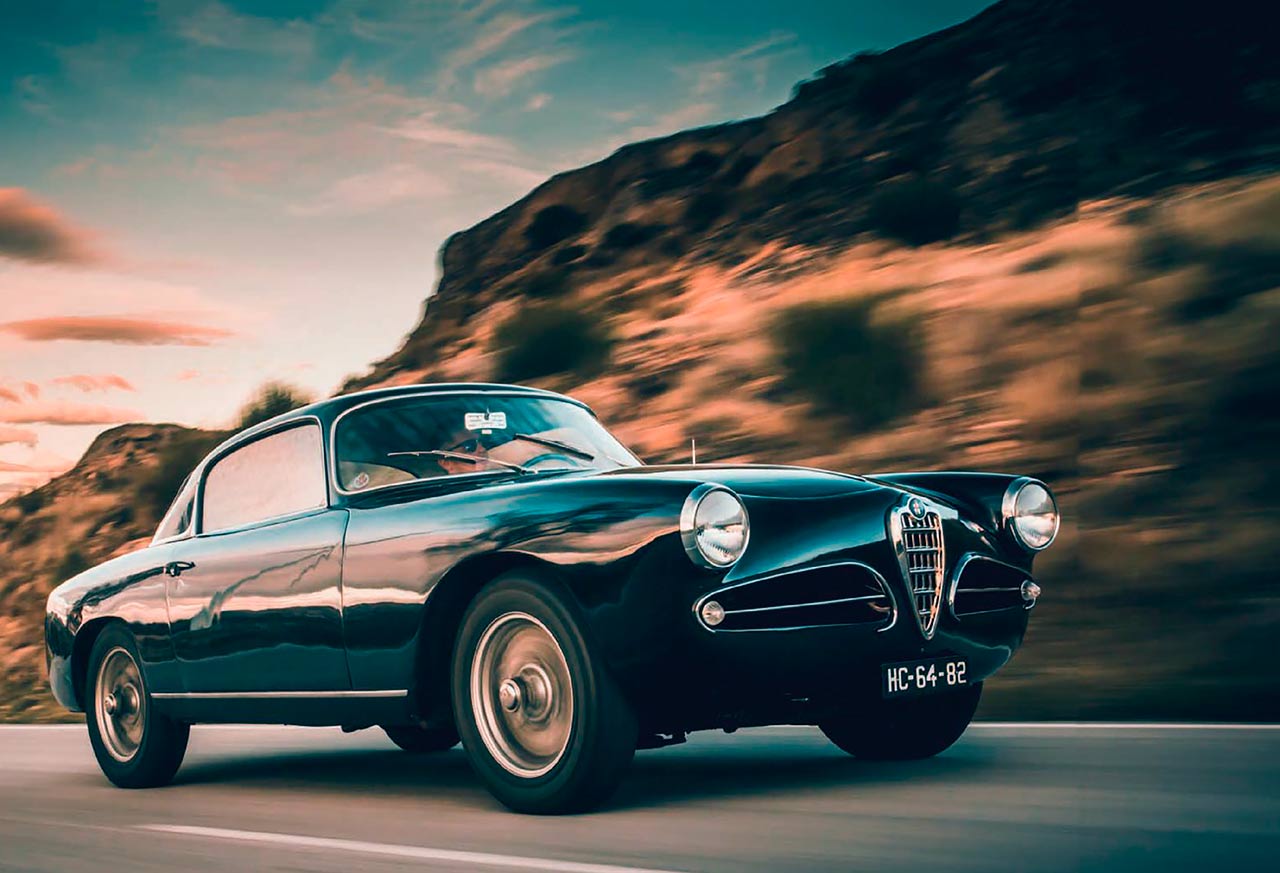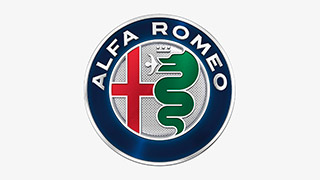
Alfa Romeo 1900CSS Into the Portuguese mountains aboard a stunning Touring-bodied Super Sprint. Motoring for the masses, Italian-Style. The 1900 was Alfa Romeo’s bid to appeal to a wider range of customers, but this Touring-bodied Super Sprint also served up a healthy dose of brio. Words Richard Heseltine. Photography Manuel Portugal.
DREAM DRIVE IN THE GORGEOUS ALFA 1900
The sky is vast in all directions and curtained by goldenpink clouds. It’s picturesque up here, that’s for sure; all scenic vistas, rock formations, pastel-hued villas and weather-worn barns. Except the view isn’t the big draw. Portugal’s Serra do Caramulo region is home to God’s own driving roads. The main thoroughfare is a historic – and still-active – hillclimb course, each lane and farm track that stems from it seemingly more akin to a rally stage. It’s easy to tell the locals from the tourists: they don’t lift for anything, a point brought home after a moped rider attempts to straight-line a series of switchbacks, which prompts millimetre-perfect avoidance action – but only on our part.

There’s not a lot to say about these roads that doesn’t end with gushy superlatives. Savouring them aboard a 1956 Alfa Romeo 1900C Super Sprint only ramps up the sense of blissed-out reverie. It isn’t the fastest car in the world, nor perhaps the best handling, but as of right now its lusty four-banger is revving its little heart out, and your hands are a blur as you work the vast helm as though you’re being chased by the devil. If there is more fun to be had in this world, it’s hard to pinpoint where. All of which may come as a surprise even to marque fans who generally view the 1900 as being… how can we put this? A bit of a truck. It isn’t. Not even close. They clearly have never driven one.
The importance of the 1900 in Alfa Romeo lore is indisputable. However, see past all the subclauses, codicils and suchlike, and one thing is clear: it never fully realised its potential. Instead the 750-series Giulietta marked the turning point as the marque made the leap to the populist mainstream. Well, that’s one theory. What is compelling about the 1900 as a breed is that it resulted in such a diverse array of spinoffs.
What was conceived as a defiantly non-glamorous saloon car spawned everything from small-series or one-off coachbuilt exotics to sport-racing cars, aerodynamic styling studies to the ‘Matta’ off-roader. This is Alfa Romeo; it couldn’t help itself. Gazing lovingly at this deliciously patinated example, and marvelling at its exquisite detailing, you cannot help but be grateful for the marque’s capriciousness. It didn’t sell in quite the sort of numbers once envisaged, but Alfa Romeo’s first all-new post-war product cast a long shadow.
Unlike most other countries, the USA included, passenger vehicle manufacture continued in Italy throughout World War 2, give or take the occasional distraction (such as, say, an RAF bombing raid). In 1943 alone, Alfa made 47 6C-2500s, with production slipping to just 18 a year later and a mere five cars in 1945. Nonetheless, this was the beginning of the end for Alfa Romeo as a boutique brand, the firm emerging from hostilities with a fresh agenda. The arrival of the 1900 at the 1950 Paris Motor Show represented a sea change at Portello, the Giulietta a further move into the accessible (if still hardly cheap) production car arena.
Up to that point, Alfa rarely made more than 800 cars per annum and, in the immediate postwar years, manufacture of vehicles was virtually nil as the firm concentrated on knocking out items such as roller shutters, window frames and cookers (complete with the Alfa Romeo script on oven doors); in fact, just about anything that would keep thousands of employees gainfully employed as the firm’s future was mapped out. The 1900 was intended from the outset for mass manufacture. Engineering deity Wifredo Ricart had conceived a new car during wartime, his streamlined ‘Gazzella’ saloon having concealed headlights and spats over all four wheels. However, it never came close to reaching production. Resources were scarce to non-existent and, as a bloodied and battered Italy dug itself out of the rubble, scores needed to be settled. The writing was on the wall and Barcelona-born Ricart didn’t hang around long enough to read it: he returned to Spain in April 1945. It was a wise decision because Alfa boss Ugo Gobbato – the man who had hired him – was assassinated a day after being cleared of having been a collaborator.
The Gazzella project was dead in the water, the 6C-2500 being reheated as a means to an end as Alfa’s new principal Consalvo Sanesi weighed up his options. The firm needed a new product and fast; something that would sell in larger numbers while still retaining the marque’s core values of style and performance. The answer was the 1900. Devised by newly installed Chief Engineer Orazio Satta Puliga, who later acted as midwife to the Giulietta, this brave new world eschewed time-honoured coachbuilding practices. Instead, his team set to with speed and relish and created a car of unitary construction for lightness and rigidity, its all-new 1884cc iron-block, alloy-headed ‘four’ producing a healthy 90bhp at 5200rpm. This was at a time when more than half of all Italian-owned automobiles had a displacement of less than 600cc, don’t forget. This sturdy short-stroke unit was allied to a column-shift four-speed ’box, while the front end was suspended via wishbones and coil springs with the live rear axle located by trailing arms, upper arms forming an A-frame, plus coils. This might be mainstream, but it is still an Alfa Romeo. That was the message.
It was warmly received, too, even if the saloon’s outline appeared unadventurous; dumpy even. Predictably, it wasn’t long before the motorsport fraternity began to take a closer look, with 1900 Berlinas competing everywhere from the Carrera Panamericana to the Mille Miglia. With success, too. This in turn led to calls for more overtly sporting variants. Alfa responded with the higher-compression Ti from ’1951 and the Super series from ’1953, the shorter wheelbase 1900C Sprint proving a boon for the many specialist body shops.
Umpteen coachbuilt confections followed, which varied from the sublime to the downright grisly. At a time when America’s Big Three were tapping up old school carrozzerie to build their show cars, some Italian stylists equally looked Stateside for inspiration. Ghia’s Giovanni Savonuzzi produced some wonderfully overblown outlines awash with tinsel, Medardo Fantuzzi’s eponymous firm producing one of the most outlandish coachbuilt 1900s called, ironically, Gazzella. Colli, meanwhile, devised an oddly proportioned coupé with a high beltline and low roofline, while Ghia-Aigle came up with a doorless roadster with cutaway flanks. Then there was Zagato’s typically leftfield competition-rooted coupé with its trademark double-bubble roof treatment, not forgetting the handsome Pinin Farina designs and trio of Franco Scaglione-penned, Bertone-built BAT showstoppers. It’s hard to think of any Latin metal-shapers of the period who didn’t conjure a bespoke 1900 of some kind.
Of all the many small-series runs, by far the most attractive were those fashioned by Carrozzeria Touring, not least when allied to a post ’1953 1900C Super Sprint platform (with a corresponding capacity hike to 1975cc and 115bhp at 5000rpm). Touring chief ‘Cici’ Anderloni always had an eye for proportion, as demonstrated by his different generations of 1900 rebodies. While interpretations of which ‘series’ is which differ between Alfa Romeo, the 1900 Register and Touring’s records from the period, unofficially there were four types of 1900 bodied by the Milanese coachbuilder.
First up, the Series 1 edition – with 1884cc engines and four-speed ’box – had longer doors than the otherwise alike Series 2 version along with flush doorhandles. The Series 3 car featured the larger-capacity engine, bigger front brakes, larger windows, different front side vents and so on. The Series 4 car was mechanically similar to the Series 3 iteration but came with a different, sleeker outline, as here. Confused? Alfa didn’t make things easy for future historians, while Touring merely compounded the misery.
Some 21,304 1900s of all types were made to ’1959, saloons accounting for 17,390. The peak year was 1953, when 5411 were shifted. The breakdown of Touring-bodied cars is roughly 300, 158, 477 and 571 first to fourth series respectively. However, these figures may be optimistic. Either way, you’re not exactly tripping over them. ‘Our’ car here has a slender competition history, having been campaigned in hillclimbs and rallies, and is now an exhibit at the superb Museu do Caramulo.
Touring rarely did ugly outlines, and the 1900CSS has an almost sculptural look to it. Denuded of its bumpers, only the polished Borranis offer that little bit of extra glitz. In period, Alfa made a special platform available specially for coachbuilders, Touring using its patented Superleggera method of construction, which comprised light aluminium panelling over a tendril-like tubular steel frame. The overall effect is compelling, the elevated bonnet line prompted by the height of the engine being expertly disguised. There isn’t a line wrong on it.
Once inside, the two-tone cabin is awash with delightful details, from the Roman font on the gauges to the delicate-looking door furniture. There’s ample headroom, too, and good vision thanks to its expansive glasshouse and spindly pillars. Nothing is a reach away, the overall effect being one of sophistication. A sense that is perhaps slightly lost on start-up; at idle it sounds a little gruff, which is to be expected. However, once up to speed the engine takes on a strident, more thoroughbred demeanour.
It’s reasonably quick for its vintage, too, with more low-down torque than you might imagine. It’s very much of its era but the 1900CCS is more than capable of keeping pace with most moderns, even when trying hard uphill. It’s a car that rewards familiarity. The steering is high-geared and heavy when dawdling, the load lightening appreciably the faster you travel with plenty of feel through the alloy-spoked wheel. The floor-mounted gearchange is close-coupled and user-friendly, but then the column shift found in earlier variants always was way better than most comparable set-ups. When driven with enthusiasm, the car handles cleanly without threatening to spill. Quite the opposite. Turn in and it leans ever so slightly but stays on its given trajectory. It really is lovely. Only the brakes let the side down: the finned drums stop the car, but you wouldn’t want to rely on them in a hurry.
What is clear is that this is no mere boulevardier, no pedestrian saloon in lingerie. While not a sports car per se, it feels sporting. Sure, it would probably be more at home eating up the miles on the autostrada, but it’s equally engaged and engaging when blatting down a mountainside. Some cars have a way of defying expectations; of worming their way into your affections. This is one of them. It may not be one of the truly great Alfas, but it’s close enough in the areas that matter. That says it all, really.
Thanks to Adelino Dinis and Tiago Patrício Gouveia of the Museu do Caramulo (www.museu-caramulo.net)
WHEN FUNCTION FOLLOWS FORM
While the 1900 was conceived as a mainstream production car, that didn’t stop the suits at Alfa Romeo initiating – or giving their blessing to – all manner of competition-led variants. The most famous was undoubtedly the C52 ‘Disco Volante’ (Flying Saucer, below). Created by Gioacchino Colombo, and built working hand-in-glove with Touring, this remarkable sports-racer looked like no other car. While based on the 1900 motor, its chain-driven four-banger featured an aluminium rather than iron block (experiments were subsequently made with straight-six units).
Unfortunately, despite – or rather because of – its shape, it didn’t win anything of any great importance. Rear-end lift was an insurmountable issue, the project being overshadowed by the hardcore 6C-3000, which briefly threatened to succeed. Cash-strapped Alfa had withdrawn from the Grand Prix arena at the end of the 1951 season, and pulled out of sports car competition at the end of ’1953. The reborn Touring concern has since revisited the theme, the 8C-based Disco Volante styled by Belgian Louis de Fabribeckers appearing at the 2012 Geneva Motor Show.
‘If there’s more fun to be had, it’s hard to see where. Some view the 1900 as a truck. It isn’t. They clearly have never driven one’
‘The 1900CSS has an almost sculptural look to it. Only the polished Borranis offer extra glitz’
Clockwise from above: beautiful view over thin-rimmed steering wheel and sculpted wings; Super Sprint bodywork appears styled to tease its way through the air; badge signifies how rare and special the little Alfa is. Clockwise from left: Alfa is a faithful, entertaining companion on a twisty road; making the most of the spring sunshine; engine is lusty but works best when revved hard.






